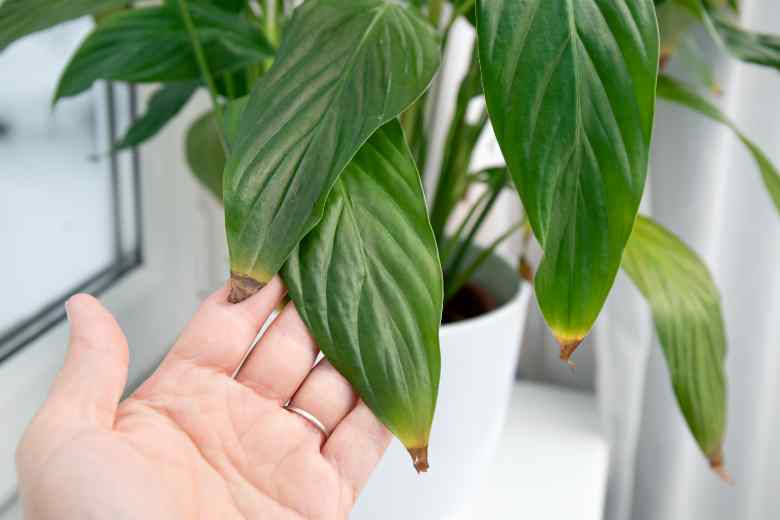
If you have a peace lily, you may have noticed its leaves turning brown. Browning of peace lily leaves is usually a sign of a cultural problem, such as too much sun, underwatering, or overwatering. When it comes to peace lilies, you need to ensure they get the right amount of light, water, and humidity.
With the right care, you can help prevent the browning of peace lily leaves and keep your plant healthy and thriving.
Causes of Browning in Peace Lily Leaves
Browning in peace lily leaves can be due to several reasons. Here are some of the most common causes:
- Underwatering or Overwatering: Peace lilies prefer a moderate amount of water. If the soil is too dry, the leaves will start to brown at the edges and then turn completely brown if the plant continues to be underwatered. Overwatering can also cause browning. It can cause root rot, which may result in browning leaves because the plant is not able to absorb water and nutrients properly.
- Low Humidity: Peace lilies are tropical plants, and they prefer a higher humidity environment. If the humidity is too low, the leaves may start to brown at the tips and edges.
- Poor Lighting: Peace lilies need plenty of indirect sunlight. If they’re placed in an area with too little light, their leaves can turn yellow or brown. On the other hand, too much direct sunlight can cause the leaves to scorch and turn brown as well.
- Fertilizer Burn: Overfertilizing, or using a fertilizer that is too strong, can cause a build-up of salts in the soil. This can lead to “fertilizer burn,” which can cause the leaf tips and edges to turn brown.
- Pest Infestation: Pests such as aphids, spider mites, and mealybugs can cause damage to peace lilies, leading to browning leaves. These pests suck the sap from the leaves, causing them to turn yellow and then brown.
- Disease: Diseases such as root rot or leaf spot can cause browning leaves. Root rot typically results from overwatering and poor drainage, while leaf spots can be caused by fungal or bacterial infections.
Each of these issues has its own specific solutions and prevention measures. For example, adjusting the watering schedule, providing adequate humidity and light, using an appropriate fertilizer, treating pests, and maintaining a healthy environment can all help to prevent or remedy browning leaves in peace lilies.
Environmental Factors Contributing to Browning
Various environmental factors can contribute to the browning of peace lily leaves:
- Water Quality: Peace lilies are sensitive to the chemicals found in tap water. Chlorine, fluoride, and other chemicals can cause browning of the leaf tips. Using filtered, distilled, or rainwater instead can help to prevent this issue.
- Temperature: Peace lilies prefer temperatures between 65 and 85 degrees Fahrenheit (18-30 degrees Celsius). They are tropical plants, so they don’t tolerate cold very well. If the temperature drops below 60 degrees Fahrenheit (15 degrees Celsius), the plant may show signs of stress like browning leaves.
- Lighting Conditions: Peace lilies need plenty of indirect sunlight. If they’re placed in an area with too little light, their leaves can turn yellow or brown. On the other hand, too much direct sunlight can cause the leaves to scorch and turn brown as well.
- Humidity: Peace lilies originate from tropical environments, which are typically humid. Low humidity levels can lead to the plant losing moisture quickly, resulting in browning leaves. Increasing the humidity around the plant, for example, by placing it on a tray with water and pebbles or using a humidifier, can help prevent this issue.
- Air Quality: Peace lilies are sensitive to certain pollutants, including volatile organic compounds (VOCs), cigarette smoke, and other toxins. Exposure to these pollutants can cause the leaves to turn brown.
- Soil Quality: If the soil quality is poor, it may not be able to provide the necessary nutrients for the plant, leading to browning leaves. The soil should be well-draining to prevent waterlogging and root rot.
Adjusting these environmental factors according to the needs of the peace lily can help prevent or remedy browning leaves.
Signs of Overwatering in Peace Lilies
Peace lilies (Spathiphyllum) are popular houseplants renowned for their lush foliage and beautiful white flowers. While they are fairly easy to care for, it’s important to avoid overwatering.
Signs of overwatering in peace lilies include wilting leaves, brown spots, drooping flowers, and yellow foliage.
To prevent this, it’s best to keep the soil moist without saturating it.
If you suspect your peace lily has been overwatered, try reducing the amount of water you give it and make sure the pot has proper drainage. With the right care, peace lilies can thrive and bring their beauty and lushness indoors.
Preventing browning in peace lilies involves a combination of proper care and suitable environmental conditions. Here are some tips:
- Watering: Make sure to water your peace lily properly. They prefer consistently moist soil but not waterlogged. Overwatering or underwatering can lead to brown leaves. You can usually tell when your peace lily needs water because the leaves will start to droop a bit.
- Humidity: As a tropical plant, peace lilies prefer higher humidity. If the air in your home is dry, consider using a pebble tray filled with water or a room humidifier to increase humidity.
- Lighting: Provide bright, indirect light for your peace lily. Too much direct sunlight can scorch and brown the leaves, while too little light can lead to yellowing and drooping.
- Temperature: Keep the peace lily in a room with a temperature between 65-85°F (18-30°C). Temperatures below this can result in leaf damage and browning.
- Soil and Fertilizer: Use a well-draining potting mix to prevent water-logging. Fertilize your peace lily sparingly – a diluted, balanced houseplant fertilizer once a month during the growing season is usually sufficient. Excessive fertilizer can cause brown leaf tips.
- Clean Leaves: Regularly clean the leaves to remove dust and boost the plant’s ability to photosynthesize. Use a damp cloth and gently wipe the leaves.
- Pest Control: Keep an eye out for pests like spider mites, aphids, and mealybugs. If you notice any, treat immediately with an appropriate insecticidal soap or neem oil.
- Water Quality: Try to use distilled or filtered water if possible, as peace lilies can be sensitive to chlorine and other chemicals found in tap water.
- Repotting: Every 1-2 years, repot your peace lily. This allows you to refresh the soil and gives the roots more room to grow.
Maintaining these optimal conditions for your peace lily will help it thrive and keep the leaves green and healthy. If you notice any browning, it’s a signal your plant is experiencing stress, so it’s crucial to identify the cause and address it as soon as possible.
Treating Brown Peace Lily Leaves
Treating existing brown leaves on a peace lily involves:
- Pruning: Use sharp, clean scissors or pruning shears to trim off the brown parts of the leaves. If an entire leaf is brown, remove it at the base. Ensure you don’t cut into healthy tissue, as this may cause further damage.
- Correct Environment: While treating brown leaves, correct any environmental issues that caused the problem. This might involve adjusting watering, light, temperature, or humidity.
- Monitor Progress: Keep an eye on your plant after trimming the brown leaves. New growth should be green and healthy. If browning continues, further investigation is needed to determine the underlying issue.
Note:
While you can trim off the brown parts of the leaves to make the plant look better, this won’t solve the underlying problem. It’s essential to identify and address the cause of the browning to prevent it from happening in the future.
Monitoring Brown Peace Lily Leaves
Monitoring brown peace lily leaves is an essential part of caring for these beautiful plants. As peace lilies are known for their lush green foliage, paying attention to the color of the leaves is key.
When the leaves start to turn brown, this can be an indication of a variety of problems, ranging from improper watering to nutrient deficiencies.
By carefully monitoring the color of your peace lily’s leaves, you can quickly identify and address any potential issues. This will ensure that your peace lily remains healthy and vibrant for years to come!
Frequently Aksed Questions
What causes brown leaves on a Peace Lily?
Answer: Browning leaves on a Peace Lily are typically caused by too much direct sunlight, overwatering, or underwatering.
How can I prevent my Peace Lily from losing leaves?
Answer: To prevent your Peace Lily from losing leaves, keep the plant in a location with bright, indirect sunlight and water only when the top inch of soil is dry.
Is there a way to revive the brown leaves on my Peace Lily?
Answer: Yes, brown leaves can sometimes be revived by removing them and allowing the plant to adjust to its environment. Ensure that your Peace Lily is in a location with bright, indirect sunlight and is being watered correctly.
Conclusion
More or less, the browning of peaceful lily leaves can be due to a variety of reasons, from too much sunlight to improper watering or even lack of humidity. It is important to pay attention to the conditions of your peace lily’s environment and make sure they are ideal for the plant’s growth and health. With the right care, you can keep your peace lily’s leaves healthy and green for a long time.





